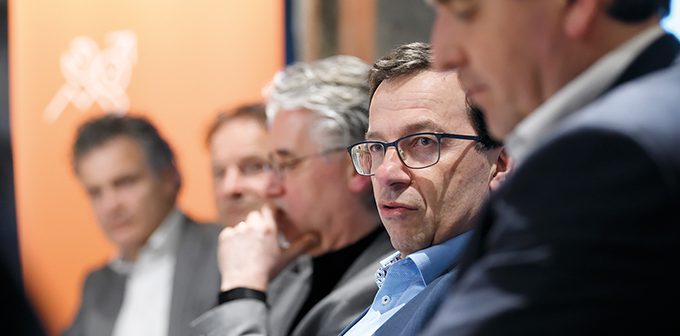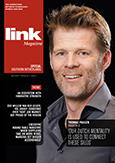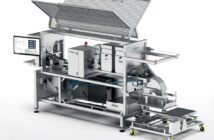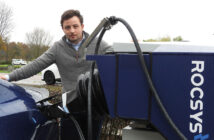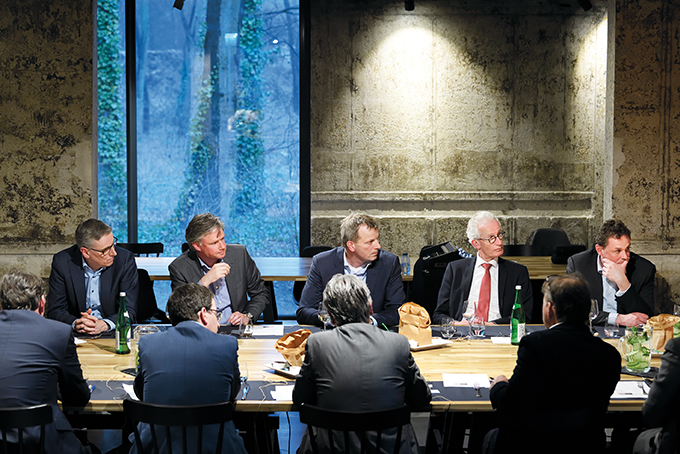
Around the table in the old reservoir (clockwise): John van Soerland, Vice President Operations, Philips Healthcare, Fokko Leutscher, Managing Director, Frencken Europe Eric Driessen, COO of Hittech, Frank Jongeneel, Managing Director Credit Riskmanagement, ING Nederland, Bas Kuper, Head of Benelux, Siemens Industry Software, Martin Dibbets, Head of VIRO Netherlands, Renco Kraak, Head of Industry, ING Mid Corporates, South-East region Edward Voncken, CEO of KMWE, Jan Kusters, CEO of Kusters Precision Parts, John Settels, CEO of Settels Savenije, Frits van Hout, executive board member of ASML, Frank Mulders, CEO of AAE, Martin van Zaalen, Editor in Chief of Link Magazine, moderator
Put a bunch of CEOs and managers from Eindhoven’s manufacturing industry (plus two people from banking) together for a whole evening at a table in an old Philips reservoir and they’re likely to see eye to eye – or sometimes not – on a variety of topics: the importance of an even stronger ecosystem in and around Eindhoven. Of many, many joint actions to make young people enthousiastic about technology. And of fist-tier suppliers co-developing on a higher level than ever with OEMs. This is what came up during the Executive Round-Table Industry of ING and Link Magazine. ‘German suppliers take on more risks, but their margins get bigger accordingly. More risks means more earnings.’
The venue for the first Executive Round-Table Industry at the end of March is the building of Settels Savenije Group, a total solution provider for the high-tech industry that moved into TAQ, the pump building at Strijp-T, a year ago. It is one of the many industrial sites in Eindhoven where Philips used to manage everything by itself. Now, renovated and new premises house companies of a completely different kind. ‘Some of our young employees find it incredible to work in an environment like this,’ says CEO John Settles.
‘When suppliers take on more risks, margins get bigger accordingly’
A common thread in the discussion is the question: ‘How do we make the ecosystem even more competitive and stronger to take on global competition?’ The industrial gentlemen (‘yes, it’s a shame, but in our sector there’s still only fourteen percent female employees’) base their discussion on four statements. An evening in four parts.
Statement 1. Companies in the Eindhoven ecosystem – under pressure from the (labour) market – take too many risks: they invest too much in capital goods and build up a too expensive salary structure.
It’s hard to sell a statement like this, according to Frits van Hout, executive board member of the OEM ASML. ‘The region emerged from a disastrous situation in which major manufacturers collapsed in the eighties. Building the smart region in which we are today, was a joint and highly driven effort. Maybe wrong investments were made here and there, but where did that not happen. As for the salaries: attracting and keeping good people is vital. Our competitors are not in Maastricht or Twente, but in San Francisco, Copenhagen and Stuttgart.’ Hence the need for good jobs, good salaries, and a pleasant living environment. Couldn’t agree more, says John van Soerland, Vice President Operations at Philips Healthcare, which could use another hundred good experts today. ‘The growing number of vacancies in high-tech is a serious threat: before you know it, we’ll no longer be able to remain the smartest region in the world.’ Salaries are undeniably rising: tertiary graduates are getting EUR 800 net more at an OEM in the region than at a supplier. Van Soerland: ‘That is difficult: If suppliers like KMWE and Frencken have to compete with that and therefore get into trouble, we as OEMs will get into trouble too.’ Moderator Martin van Zaalen: ‘Everyone is fishing in the same pond. Those with the biggest bate will haul people in, whereas the aim should be to optimise the whole supply chain.’
‘More risk means more profit. No customer will be happier than ASML if you want to take the burden from us.’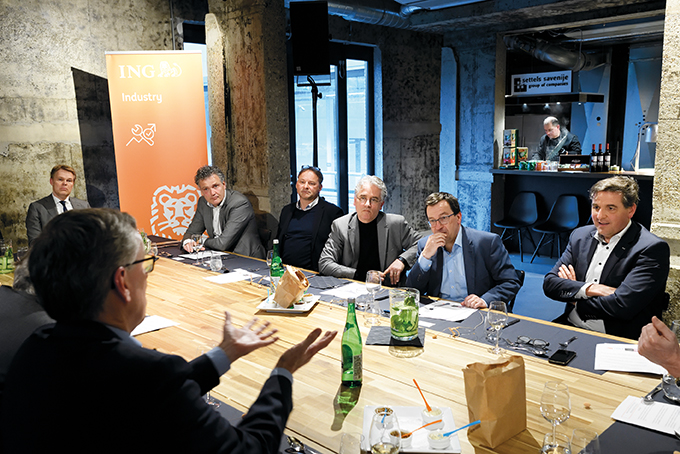
A split has become noticeable: recruiting higher educated people in and outside the country for innovation and design is one thing. But, listening to talk around the table, it’s on the technical graduates’ side that there’s more pressure and cause for concern. In their experience, the participants say, there is still too little awareness in the Netherlands of how important the manufacturing industry is. The service economy has traditionally been dominant in the Netherlands: careers are made in offices or banks, some say.
Not too late
Recruiting professionals remains complicated. ‘Was it that much different twenty, thirty years ago?’ Kusters Precision Parts CEO Jan Kusters wonders. Eric Driessen, CEO of the system supplier Hittech: ‘We recognise the problem of a shortage of professionals, but with finding higher educated people we have fewer problems in the region of The Hague and surroundings.’ ‘It’s tense in technology, but it’s really not too late yet,’ says CEO Frank Mulders of the machine manufacturer AAE in Helmond. ‘Keep investing to make technology sexier. Go to the schools, draw the kids to your industry, go and stand on that sports field and inspire them. It’s not easy, we need a lot of people, but AAE still knows how to find manpower.’
‘You don’t have any problems, because like us, you continue to invest in training’, Edward Voncken from KMWE, expert in High Mix, Low Volume and High Complexity machining, reminds his CEO colleague. ‘The companies that complain the hardest, crying “Where are the people, I can’t find any”, are those that don’t invest time and money to reach out to the younger generation.’ ‘I don’t have any proof, but that might be so,’ Mulders comments drily. ‘A lot is happening already; look at the Dutch Technology Week and Techniekpact (aimed at improving the connection of engineering education to the labour market, ed.), for example. But let’s promise each other that we’ll join forces even more regularly to get more people interested in technology. And women in particular, because their share is looking dismal compared to other countries,’ Frits van Hout adds. Fokko Leutscher, Managing Director of Frencken Europe: ‘And especially, don’t forget to invest in your current people to make them more flexible.’
What works wonders for our appeal as an employer is new premises like these, says host John Settels van Settels Savenije. ‘We offer an attractive environment, freedom, good projects… That attracts people.’ Salaries help, but what young people really want, is a job that matters, a job with impact, Frank Mulders finds.
Sensitive to economic fluctuations
The manufacturing industry folk want to know more from Frank Jongeneel, Managing Director Credit Riskmanagement at ING Nederland, about that first part of the statement, namely physical investments. How does he see it? Jongeneel: ‘We’re emerging from a long period of crisis. Getting investments started up again is not that easy for some suppliers. I see companies not taking too many risks, I do feel they shouldn’t just ask help from the banks, but that they should look further to other forms of financing and be prepared to take other risks.’ And yes, the banks also learnt something from the crisis: ‘We saw investment write-downs in companies that we never expected would disappear.’
Is the region sensitive to economic fluctuations, can it absorb future setbacks? Eindhoven and environs have become less sensitive, those present feel, even the semiconductor sector where forty percent down or up was quite usual in the past. Chips are everywhere, there are fewer fluctuations in the equipment industry than ever. Frits van Hout: ‘And remember, the last crisis was especially a financial one, rather than an economic trough.’

John van Soerland(Philips Healthcare), Fokko Leutscher (Frencken)
Statement 2. Large OEMs must give their (co-)development key suppliers IP rights to make it easier for them to recoup their development investments, also in other sectors.
Must, must, must. There are no ‘musts’ for OEMs. ‘Say rather that suppliers must earn those rights,’ Fokko Leutscher retorts. ‘Key suppliers must make an effort to develop their core skills further, to slot in with those of OEMs. Where is the OEM going, where are we going? It takes two to tango.’ OEMs will define their core business more clearly, and first-tier suppliers will therefore be able to ask themselves what more they can offer. Leutscher: ‘Then suddenly you’ll hear an entirely different discourse. We sat with a customer who sorely needed their own engineers for their own work. Until recently they were used to just paying us as supplier for our hours and materials. Now it was about what it was worth to them if we developed the know-how ourselves.’ That’s how you build a long-term relationship. The OEM has more space, the supplier gives key support: ‘Our margins are rising slightly, and we can apply the developed know-how and technology to other markets as well.’
No-one has mentioned the word IP yet. Edward Voncken from KMWE distinguishes two types of IP: product IP and manufacturing IP. ‘The second is about smart manufacturing. That’s what we do. It’s the know-how that we have and the development of manufacturing, which is hard to establish, it’s not so much tangible know-how.’ The whole IP issue may well be played out between specific product competitors. Everyone agrees that it does not play a large part in the manufacturing chain. Suppliers are not there to build up IP. ‘Look at the possibilities, don’t focus on protection,’ says Frits van Hout. ‘At the start, ASML was a poor offspring of Philips. We just had to outcource the production of parts. Now we’re making really complex machines and we want to be able to entirely outsource the development of certain modules. It’s up to the suppliers to come up with new ideas.’ He realises that it’s difficult for companies who have always been on the manufacturing side. AMSL wants to help companies who can and want to do it. Van Hout: ‘In the long run, it’s in both parties’ interest. I’m thinking of it as a kind of marriage, with just one partner. A second partner won’t fit in. And mutual threats won’t work in a marriage either. You must leave room for each other.’ Duty comes before rights. Anyone who’s manufacturing something, usually has to wait for his money. Those who manufacture and develop, have to be even more patient. The head of ASML has a model in mind where suppliers will co-develop and certainly use the know-how for other customers too. Who’s talking of IP? IP seldom has a positive ring to it, and heats matters up unnecessarily in the customer-supplier relationship.
Settels notes that, with his R&D team, he actually is successfully engaging in a dialogue with customers to develop IP together and then create space to deploy the developed IP in markets where his customer is not active. Such cooperation is beneficial for both parties, because Settels can quickly build up know-how that is also interesting to the customer, and the customer shares in the benefits from business outside his normal market.
Statement 3. Key-suppliers are still not doing enough to show that they are taking their bigger responsibility seriously. They must also invest in research and customer knowledge.
‘Yes, I agree,’ Fokko Leutscher readily admits. ‘If we want to play a bigger part, we must invest a lot more. At Frencken we’re getting there: till recently our engineering was a pure profit centre. As if we were just selling engineering hours. But that’s not good enough, we thought, we’re turning it into a cost centre. Development doesn’t always have to be 100% profit-making, it may also cost money to raise your own organisation to higher level.’
Frits van Hout of ASML sees a big difference between the Netherlands and Germany: ‘Don’t get me wrong, it’s an observation, not a value judgement. The Netherlands without any doubt has competent suppliers and great knowledge institutions. ASML can do a lot with that. But Germany has got a lot of bigger – as well as smaller – business, often family-owned, with a long-term vision, which offer the full package of development and manufacturing. It would be good for the Dutch manufacturing industry if we more and more could have the same model. Suppliers carry more risks, but margins increase accordingly. More risk means more profit. No customer will be happier than ASML if you want to take the burden from us. So go for it, we’re waiting.’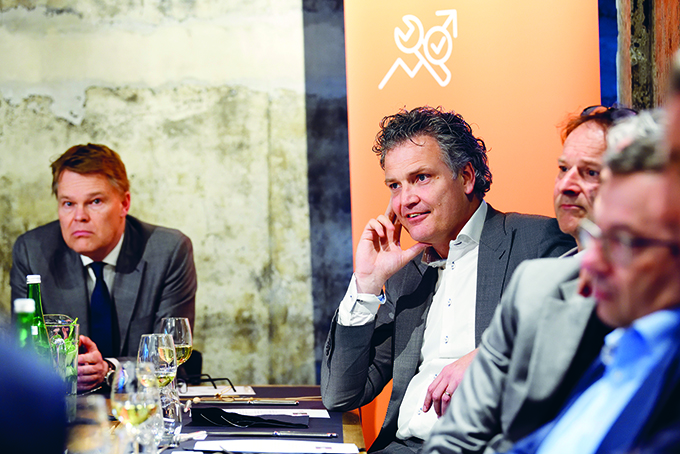
Of course, the transition to more responsibility and co-development is difficult, for the supplier and for the OEM. Letting go is just as hard as taking over. Ask John van Soerland of Philips. ‘Compared to ASML, Philips comes from quite the opposite sourcing model, where we do everything in-house from beginning to end. We’re still finding it hard to draw the line of what we want or don’t want to outsource. Apart from that, two issues seem important to him: suppliers must shoulder the burden and must be able to service Philips worldwide. ‘We try to limit the number of different suppliers and to avoid smaller suppliers. They are great people and they offer good products, but they are the ones who supply our suppliers.’ Plus you can’t expect smaller second-tier companies to co-develop and put money into it. For first-tier suppliers it’s a must. That’s the way that suppliers in the region should go if they want to take on global competition.
With regard to following and serving OEMs worldwide, engineering firm VIRO is a good example. Martin Dibbets, Head of VIRO Nederland: ‘We now work for ASML in the Netherlands from all of our five branches and in Germany from one branch. We also work for many of their first-tier suppliers, including large German partners of ASML. ‘
Statement 4. The ecosystem should agree on the use of one design model and one set of rules, and on how to communicate digitally within the chain.
That would bring huge advantages, according to the gentlemen around the table. They mention terrible examples of what can go wrong when parties receive orders and realise that products or components don’t fit exactly, or not at all, due to (digital) communication errors. ‘We can save about thirty percent on costs with better coordination,’ Benelux manager Bas Kuper from Siemens Industry Software claims. ‘Always agree beforehand on the CAD/CAM and PLM package of the OEM you’re working for.’ At the same time: technology is progressing, there’s more open software, things are getting easier to organise, systems can share information and communicate more efficiently. But a lot still needs to be optimised.
Edward Voncken from KMWE: ‘And when you’ve coordinated everything perfectly in 3D, a quality official comes by to check and control it, and says: “Give me a 2D printout of the drawing otherwise I can’t put a stamp on it.” That sets your teeth on edge.’ John van Soerland sighs when he thinks of the Food and Drug Administration with their own stack of little rules and regulations to validate for instance medical devices. Of course, this is all intended to guarantee the safety and health of patients and medical staff optimally. ‘If it is not documented, it is not done’, is a famous FDA statement.’
But to get back to the region: are OEMs like Philips and ASML for instance on the same line when it comes to design models and rules, or is it a hopeless case, is the question around the table. ‘That thing about uniform models between OEMs is not on the agenda for me,’ says Frits van Hout from ASML. ‘Maybe it’s not good.’ Previously, Philips had a notorious ‘blue map’ full of standards. ‘If we made a modern version of it, it could save a lot,’ Van Soerland thinks. ‘But then within long-term partner relationships, to use that comparison again. If a frequent change partners occurs, it will not work.’ What are you aiming for, Martin Dibbets from VIRO wants to know. ‘It would be a good thing for dominant parties to set standards, but do not let them limit the creativity which is much needed for innovation. With more freedom, you can sometimes actually get better products.’
Executive Round-Tables
This is the first in a series of four regional Executive Round-Tables Industry that ING organises with Link Magazine at various locations in the Netherlands. Renco Kraak, Head of Industry at ING Mid Corporates, South-East Region: ‘ING and Link also want to emphasise the importance of the manufacturing industry for the Netherlands and to draw attention to this. In addition to chain cooperation, themes include robotisation and servitization.’

